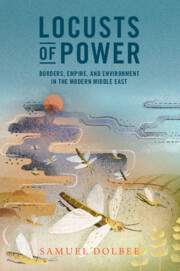Book contents
- Locusts of Power
- Reviews
- Studies in Environment and History
- Locusts of Power
- Copyright page
- Contents
- List of Figures and Maps
- Preface
- Acknowledgments
- Note on Spelling and Units of Measurement
- Introduction
- 1 Sultans of the Open Lands (1858–1890)
- 2 “Savage Swarms” (1890–1908)
- 3 “Weren’t We A Lot Like Those Creatures?” (1908–1918)
- 4 “Like Swarms of Locusts” (1918–1939)
- Conclusion
- Bibliography
- Index
3 - “Weren’t We A Lot Like Those Creatures?” (1908–1918)
Published online by Cambridge University Press: 16 June 2023
- Locusts of Power
- Reviews
- Studies in Environment and History
- Locusts of Power
- Copyright page
- Contents
- List of Figures and Maps
- Preface
- Acknowledgments
- Note on Spelling and Units of Measurement
- Introduction
- 1 Sultans of the Open Lands (1858–1890)
- 2 “Savage Swarms” (1890–1908)
- 3 “Weren’t We A Lot Like Those Creatures?” (1908–1918)
- 4 “Like Swarms of Locusts” (1918–1939)
- Conclusion
- Bibliography
- Index
Summary
Chapter 3 examines Armenian deportees and locusts in the Jazira between 1908 and 1918. It places the Armenian genocide within the longer history of efforts to control the Jazira, as the district created for the settlement of nomads in 1871 transformed into the final destination for many of the empire’s Armenian citizens. The chapter exposes the complicated ways the violence affected and was affected by the environment. One German locust expert even suggested that the deportations of the genocide coupled with war mobilization to make the locust invasions worse because so much land was left fallow. But the environment also managed to help some escape, whether children who survived by working as shepherds for pastoralists or the Armenian who, while concealing his identity, worked as the locust-control officer of the Jazira. In a mark of the enduring challenge of the Jazira and its provincial division, Ottoman officials discussed how to draw better borders in the region throughout, from the lead-up to deportations in 1915 all the way to the end of the war in 1918.
- Type
- Chapter
- Information
- Locusts of PowerBorders, Empire, and Environment in the Modern Middle East, pp. 135 - 190Publisher: Cambridge University PressPrint publication year: 2023



